Arto's Blog
Pages: << 1 2 3 4 ...5 ...6 7 8 ...9 ...10 11 12 ... 31 >>
Cycling and camping in Chilean summer
Posted: 2014-12-13 14:52:00, Categories: Travel, Cycling, Chile, 931 words (permalink)
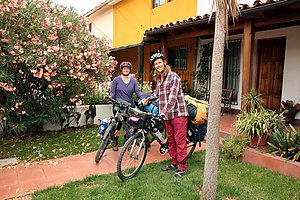 Our honeymoon trip has begun. We are currently in Curacautin in Chile,
about 600 km south of Santiago and will continue towards the south. We
plan to travel mainly by bicycle and take a bus or ferry for some
parts of the way to reach Ushuaia, Argentina by the end of
February. Here on the southern hemisphere it's the beginning of
summer, with daily maximum temperatures between 20 and 30 °C and
nightly minimum around 10 °C. It will get colder towards the south, but
should still be good weather for camping and outdoor life.
Our honeymoon trip has begun. We are currently in Curacautin in Chile,
about 600 km south of Santiago and will continue towards the south. We
plan to travel mainly by bicycle and take a bus or ferry for some
parts of the way to reach Ushuaia, Argentina by the end of
February. Here on the southern hemisphere it's the beginning of
summer, with daily maximum temperatures between 20 and 30 °C and
nightly minimum around 10 °C. It will get colder towards the south, but
should still be good weather for camping and outdoor life.
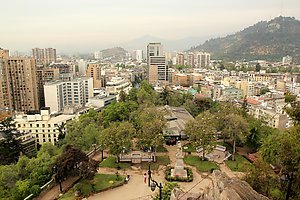 We packed our bicycles and other gear in two carton boxes and two
backpacks and flew to Santiago, where we had the pleasure of staying
with the family of Elba, our Spanish teacher in Germany. That was a
great introduction to Chilean culture and a full time Spanish course
for a week, with different family members coming by and talking with
us. In addition to seeing around in the city and spending time with
the family we took care of various practical things such as changing
money, getting Chilean SIM cards for our phones and reassembling our
bicycles. We also did a 1,5 day bus trip to Valparaiso, a seaside city
with old colourful houses on hills.
We packed our bicycles and other gear in two carton boxes and two
backpacks and flew to Santiago, where we had the pleasure of staying
with the family of Elba, our Spanish teacher in Germany. That was a
great introduction to Chilean culture and a full time Spanish course
for a week, with different family members coming by and talking with
us. In addition to seeing around in the city and spending time with
the family we took care of various practical things such as changing
money, getting Chilean SIM cards for our phones and reassembling our
bicycles. We also did a 1,5 day bus trip to Valparaiso, a seaside city
with old colourful houses on hills.
 From Santiago we took a bus 400 km south to Chillan, a city of about
160 000 inhabitants in the Bio-Bio region. It was already much more
relaxed than the metropolitan region and our Couchsurfing host Camila
took us to a trip to the nature near the mountains. We walked to an
idyllic spot by the Diguillin river, went swimming in the crystal
clear water and had a picnic on the riverside rocks enjoying the
sun. There was also a beautiful waterfall with a possibility to go in
a small cave behind the falling water.
From Santiago we took a bus 400 km south to Chillan, a city of about
160 000 inhabitants in the Bio-Bio region. It was already much more
relaxed than the metropolitan region and our Couchsurfing host Camila
took us to a trip to the nature near the mountains. We walked to an
idyllic spot by the Diguillin river, went swimming in the crystal
clear water and had a picnic on the riverside rocks enjoying the
sun. There was also a beautiful waterfall with a possibility to go in
a small cave behind the falling water.
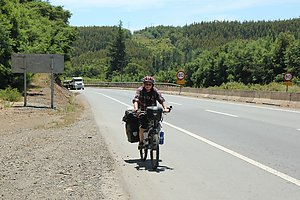 From Chillan we started our cycling tour, first following the
Pan-American Highway (Panamericana). It is the main route going
across the whole North, Central and South America. It was noisy and
not the nicest road to cycle on, but quite safe because of the large
shoulders and not as bad for the amount of traffic as most highways in
Germany. In some places it was also possible to ride on a smaller
service road next to the main highway.
From Chillan we started our cycling tour, first following the
Pan-American Highway (Panamericana). It is the main route going
across the whole North, Central and South America. It was noisy and
not the nicest road to cycle on, but quite safe because of the large
shoulders and not as bad for the amount of traffic as most highways in
Germany. In some places it was also possible to ride on a smaller
service road next to the main highway.
About 80 km further south we stopped to see Saltos de Laja, well known waterfalls near the Panamericana. The walkway to the falls was lined with snack and souvenir shops, but the waterfalls themselves and the river were in a natural state, not spoiled with fences or other constructions. A great view and a refreshing shower of millions of tiny waterdrops carried by the wind from the falls.
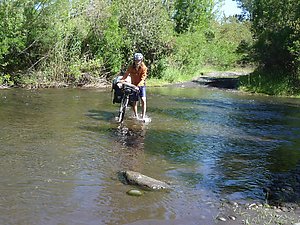 After Saltos de Laja we chose an alternative route and got our first
taste of gravel roads in Chile. First it was quite good to cycle but
soon turned into fairly rough and narrow road. At one point we even
had to cross a 10 meters wide and 20 cm deep river. One house had a
sign saying cheese for sale — we bought some homemade fresh
cheese and got a big bag of cherries from the garden as a present. It
took us more than 3 hours to cycle the 20 km gravel section, but
traffic was minimal and the scenery beautiful so it wasn't too bad.
The last 10 km were nice, paved, quiet road and after that we joined
the Panamericana again for two days.
After Saltos de Laja we chose an alternative route and got our first
taste of gravel roads in Chile. First it was quite good to cycle but
soon turned into fairly rough and narrow road. At one point we even
had to cross a 10 meters wide and 20 cm deep river. One house had a
sign saying cheese for sale — we bought some homemade fresh
cheese and got a big bag of cherries from the garden as a present. It
took us more than 3 hours to cycle the 20 km gravel section, but
traffic was minimal and the scenery beautiful so it wasn't too bad.
The last 10 km were nice, paved, quiet road and after that we joined
the Panamericana again for two days.
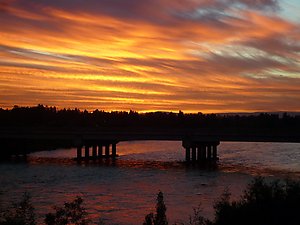 During the 240 km between the cities of Chillan and Victoria we
camped four nights, every time next to a river. One of them was a
campsite with facilities, in all other cases we just looked for a
place ourselves or asked the locals where to pitch the tent. Sometimes
it took a bit of time to find a suitable spot, as fields and
forests tend to be surrounded by fences, but mostly it was quite
easy. The rivers were clean and good to swim in, for cooking and
drinking we filled our water bottles beforehand at a gas station or
by asking for water at a house by the roadside. We're glad that tap
water is drinkable almost everywhere in Chile, so we don't have to buy
and leave behind heaps of plastic bottles.
During the 240 km between the cities of Chillan and Victoria we
camped four nights, every time next to a river. One of them was a
campsite with facilities, in all other cases we just looked for a
place ourselves or asked the locals where to pitch the tent. Sometimes
it took a bit of time to find a suitable spot, as fields and
forests tend to be surrounded by fences, but mostly it was quite
easy. The rivers were clean and good to swim in, for cooking and
drinking we filled our water bottles beforehand at a gas station or
by asking for water at a house by the roadside. We're glad that tap
water is drinkable almost everywhere in Chile, so we don't have to buy
and leave behind heaps of plastic bottles.
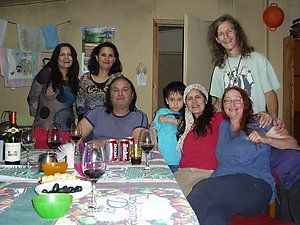 In Victoria we thought about going to a guesthouse, but had hard
time deciding whether to look for one in the city or cycle still a bit
forwards. Just as we thought about leaving from the tourist info, a
woman came to talk to us and invited us for a tea at her home. She was
Veronica, an English teacher who wanted to practise her English with
us. That suited us perfectly, we followed her to her house, had not
only tea but also something to eat and soon also a place to stay. Her
sisters and other members of the family came to meet us too so we had
both English and Spanish practise. We showed some photos of Finland
and Germany, had a bit of wine and spent a nice evening with our new
friends.
In Victoria we thought about going to a guesthouse, but had hard
time deciding whether to look for one in the city or cycle still a bit
forwards. Just as we thought about leaving from the tourist info, a
woman came to talk to us and invited us for a tea at her home. She was
Veronica, an English teacher who wanted to practise her English with
us. That suited us perfectly, we followed her to her house, had not
only tea but also something to eat and soon also a place to stay. Her
sisters and other members of the family came to meet us too so we had
both English and Spanish practise. We showed some photos of Finland
and Germany, had a bit of wine and spent a nice evening with our new
friends.
From Victoria we continued further east towards the mountains on a nice, relatively quiet paved road. We saw some amazing volcanic scenery in Malalcahuello National Reserve, and tomorrow we're heading to the Conguillio National Park, planning to cross it from north to south.
Back home in Germany we arranged through CouchSurfing that a small Czech family of three are living in our flat through winter and spring until we're coming back. They're taking care of our cat Germaine, so we can travel with a peaceful mind knowing that she's in good hands.
Wedding with a sauna
Posted: 2014-09-19 23:50:00, Categories: Travel, General, 509 words (permalink)
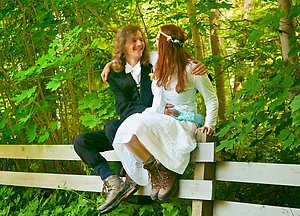 Sandra and I are married now. Our wedding took place at
a red wooden house by a lake with a sauna for relaxing after the main
party. We had beautiful weather, excellent food, great music, and
around 50 friends and relatives celebrating with us on our special
day.
Sandra and I are married now. Our wedding took place at
a red wooden house by a lake with a sauna for relaxing after the main
party. We had beautiful weather, excellent food, great music, and
around 50 friends and relatives celebrating with us on our special
day.
We wanted a leisurely atmosphere where nobody would feel being in a hurry. So we chose a location surrounded by nature and rented the place for the whole weekend. Preparations were done on Friday evening and guests were invited to come around midday on Saturday. There was no deadline at what time the party should end, and everybody who wanted could stay overnight until Sunday without any extra cost. Also our bed for the wedding night was prepared at the attic of the main house — we didn't see any reason to leave our own party and go to sleep in a hotel.
 The wedding ceremony was outside at the lakeshore, accompanied with
didgeridoo tunes which many guests found quite exciting. After the
formalities we received congratulations and raised a toast with
everybody, followed by a buffet style meal. My father gave a speech,
my brother sang and our friends entertained the guests by inviting
us in the traditional shoe game. Then four ex-colleagues of mine
from CSC took the stage with their guitars and drums: it was time
for the wedding waltz. After an hour of dancing, cake was served and
music turned towards rock. During the following two hours about half
of the guests said their goodbyes, heading back home. But the party
was still far from over.
The wedding ceremony was outside at the lakeshore, accompanied with
didgeridoo tunes which many guests found quite exciting. After the
formalities we received congratulations and raised a toast with
everybody, followed by a buffet style meal. My father gave a speech,
my brother sang and our friends entertained the guests by inviting
us in the traditional shoe game. Then four ex-colleagues of mine
from CSC took the stage with their guitars and drums: it was time
for the wedding waltz. After an hour of dancing, cake was served and
music turned towards rock. During the following two hours about half
of the guests said their goodbyes, heading back home. But the party
was still far from over.
 The sauna was hot starting from 8 pm. Sandra and I originally met
at a sauna evening in Helsinki so it was natural to have sauna in
our wedding too. The first hour was reserved for women, after that
all were welcome to join. The cook, the waiters and the band members
came as well. Fancy clothes were changed into towels,
people went swimming in the lake, came back for another round in the
sauna, chatted with each other on the terrace. After the sunset the
band brought their acoustic instruments and played for several hours
into the warm summer night: a perfect ending to the long day.
The sauna was hot starting from 8 pm. Sandra and I originally met
at a sauna evening in Helsinki so it was natural to have sauna in
our wedding too. The first hour was reserved for women, after that
all were welcome to join. The cook, the waiters and the band members
came as well. Fancy clothes were changed into towels,
people went swimming in the lake, came back for another round in the
sauna, chatted with each other on the terrace. After the sunset the
band brought their acoustic instruments and played for several hours
into the warm summer night: a perfect ending to the long day.
On Sunday morning we had breakfast together with everybody who had stayed overnight. There was still plenty of food left so all who wanted could take some and skip cooking for the next couple of days. With the help of guests we cleaned up the place and headed back home, exhausted but happy.
Our honeymoon trip will be to South America and Antarctica during the summer months of the Southern Hemisphere — which means during the winter in Europe. Details are still open, but because we like slow travel, the trip will certainly be longer than just one month. Before leaving, we'll spend the autumn at home in Southern Germany.
The photos on this page were taken by Panu Hällfors, all rights reserved. Please take a look at the larger selection on his home page.
Introducing Germaine
Posted: 2013-12-20 21:55:00, Categories: Travel, General, Germany, 398 words (permalink)
 Let us introduce Germaine, our new furry companion. She likes to lie
down and relax, not worrying too much about what's happening in the
world. She follows us around in the flat and knows how to get food
and attention. She miaows or squeeks in a special way, lifts her tail up and
vibrates it. She has hurt her tail at some earlier time in life and
cannot move the last part, so it forms a funny looking arc. When not
eating, Germaine's favourite place is on the bed. Sounds like a
comfortable and easy life, doesn't it?
Let us introduce Germaine, our new furry companion. She likes to lie
down and relax, not worrying too much about what's happening in the
world. She follows us around in the flat and knows how to get food
and attention. She miaows or squeeks in a special way, lifts her tail up and
vibrates it. She has hurt her tail at some earlier time in life and
cannot move the last part, so it forms a funny looking arc. When not
eating, Germaine's favourite place is on the bed. Sounds like a
comfortable and easy life, doesn't it?
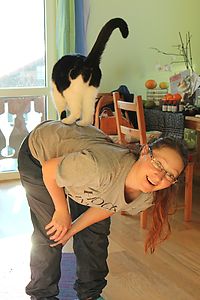 Germaine spent her first 15 years with an elderly lady,
who passed away a few months ago. She needed a new home and we
decided to offer ours. It took her a while to get used to us and the
new environment, but now it feels like she had always been here.
For her age, equivalent to around 75 human years, she's quite fit.
She suffers from digestion problems, needs special food and
medicine, but otherwise she seems to be a happy cat.
Germaine spent her first 15 years with an elderly lady,
who passed away a few months ago. She needed a new home and we
decided to offer ours. It took her a while to get used to us and the
new environment, but now it feels like she had always been here.
For her age, equivalent to around 75 human years, she's quite fit.
She suffers from digestion problems, needs special food and
medicine, but otherwise she seems to be a happy cat.
We don't have a garden where Germaine could go out, but she is anyway not used to it after spending all her life indoors. When we open the balcony door, she may shortly step outside to smell fresh air, but comes soon back in. First we were careful as we thought she might jump down on the neighbour's balcony, but she doesn't seem to even consider that. An even if she would, it wouldn't be too bad as the neighbour below us likes cats too.
 After returning from Thailand and Laos in May, Sandra has been
working again, this time in a laboratory together with her best
friend. I spent a couple of months in Finland during the summer and
after that I've had various small projects like renovating our
balcony. We also bought a wood oven so we can enjoy watching flames
and keep our flat warm without being dependent on oil.
After returning from Thailand and Laos in May, Sandra has been
working again, this time in a laboratory together with her best
friend. I spent a couple of months in Finland during the summer and
after that I've had various small projects like renovating our
balcony. We also bought a wood oven so we can enjoy watching flames
and keep our flat warm without being dependent on oil.
It looks like we'll spend at least the winter and early spring mostly here in Germany. A hint to our friends: if you've been thinking of visiting us, now would be a good time! Sooner or later we'll probably go travelling again and will also need to find someone to take care of Germaine. However, for now she's living here with us and bringing us joy.
Blog software upgrade helped with comment spam
Posted: 2013-09-30 18:41:00, Categories: General, Free software, 487 words (permalink)I recently upgraded the software of my blog to the most recent version of b2evolution. The main reason was simply to stay current with security and bug fixes. Another reason was the new "mass delete" option to get quickly rid of comment spam. As a nice surprise, most of the daily load of spam disappeared without even needing to go through and remove it.
My blog doesn't have a large number of followers, who would regularly comment on the articles. Over 90% of the comments have already for a long time been spam, senseless junk messages trying to advertise some product. I haven't really understood why the spammers have been so persistent: the comments are moderated which means that their message never gets out to the public anyway. Besides, a Captcha plugin at the bottom of the comment form is at least attempting to make sure that commenters are humans and not spam generating robots. I'm not using the centralized blacklist of b2evolution, because I don't want to block domains or content based on keywords, at least if I haven't selected the blocking criteria myself.
In any case, by summer 2013 the situation had gotten pretty bad. The blog was collecting more than a thousand spam comments per month, the traffic of my website exceeded 10GB/month, and over 70% of hits were coming from China. That sounded strange: my site has no content about China or in Chinese language. A couple of Chinese sites link to a few of my photos, but that didn't explain the big mass of visits. Logs showed that most of the traffic was requesting articles from the blog and posting comments on them.
After the upgrade, the number of spam comments dropped immediately to about one per day. The share of hits coming from China dropped to less than half of the total, although it's still surprisingly high at 40%. When looking at the amount of transferred data, connections from United States are leading with about 30% of total, Chinese traffic is less than 10%. Before the upgrade, the amount of traffic from China was equal to that from the U.S.. Finland comes as number three, but far behind the top two. That sounds reasonable — as I write in English it's not a big surprise to have more visitors from U.S. than from Finland.
The most likely conclusion coming to my mind is that the old version of the software had a bug, allowing comments to be posted by automated scripts without going through the Captcha. Although I didn't change the Captcha plugin itself, now it seems again to keep most of the spam out. Or the scripts used by spammers simply aren't upgraded yet to match the new b2evo. Whatever the reason, let's hope it stays like this at least for a while.
Non-spam comments are welcome. :-) Particularly, if you notice something has been broken due to the upgrade, I'd be happy to hear about it.
Sabai dii Pi Mai Lao
Posted: 2013-04-30 14:00:28, Categories: Travel, Cycling, Laos, 903 words (permalink)
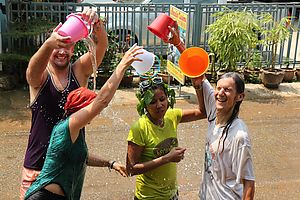 In Mid-April, in the town of Vang Vieng, we attended the cheerful
celebration of Pi Mai Lao, the Lao New Year. Hundreds of people poured
small buckets of water over us, wishing us Happy New Year. We joined
the teams by the roadside and did our own share of watering people
passing by. Beer Lao was generously offered to friends and strangers
alike, music was played from large loudspeakers all around the town
and everybody had a great time.
In Mid-April, in the town of Vang Vieng, we attended the cheerful
celebration of Pi Mai Lao, the Lao New Year. Hundreds of people poured
small buckets of water over us, wishing us Happy New Year. We joined
the teams by the roadside and did our own share of watering people
passing by. Beer Lao was generously offered to friends and strangers
alike, music was played from large loudspeakers all around the town
and everybody had a great time.
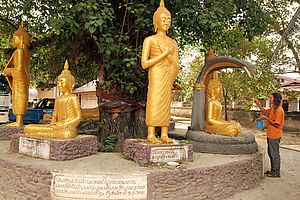 Traditionally, people prepare flowers and perfumed water which is
taken to temples and sprinkled over buddha statues. Some of the
water is carried back home and gently poured on relatives and
friends, to purify them and give a good start for the New Year. This
all still happens and the Buddhist New Year is a beautiful time to
visit a temple, stop for a prayer and do the ceremony following the
locals. We also did.
Traditionally, people prepare flowers and perfumed water which is
taken to temples and sprinkled over buddha statues. Some of the
water is carried back home and gently poured on relatives and
friends, to purify them and give a good start for the New Year. This
all still happens and the Buddhist New Year is a beautiful time to
visit a temple, stop for a prayer and do the ceremony following the
locals. We also did.
 A newer habit is to stand in small groups by the roadside, armed
with a garden hose, buckets and water guns, and to pour or throw
water on everyone who passes by. People in Laos usually drive small
motorcycles, which makes them good targets. Even the majority of
cars are pickups or half-open trucks, with people sitting in the
back unprotected from water. If someone doesn't like to get wet,
it's simply best to stay indoors. Most people don't mind, as it's
part of the New Year and the sun dries everything quickly
anyway.
A newer habit is to stand in small groups by the roadside, armed
with a garden hose, buckets and water guns, and to pour or throw
water on everyone who passes by. People in Laos usually drive small
motorcycles, which makes them good targets. Even the majority of
cars are pickups or half-open trucks, with people sitting in the
back unprotected from water. If someone doesn't like to get wet,
it's simply best to stay indoors. Most people don't mind, as it's
part of the New Year and the sun dries everything quickly
anyway.
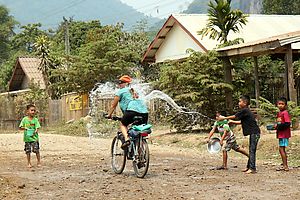 In the gentle and polite version of the New Year greeting, people
first wave the driver to stop. Then they pour a small amount of
water on the neck so that it runs down along the back, accompanied
with a cheerful wish of "Sabai dii Pi Mai", "Souksan van Pi Mai" or
"Suk dii Pi Mai", which translate to "Happy New Year" or "Good
luck for the New Year". If someone has a bag or something else which
shouldn't get wet, it can be lifted up so that no damage is done.
Especially elderly people were mostly greeted this way.
In the gentle and polite version of the New Year greeting, people
first wave the driver to stop. Then they pour a small amount of
water on the neck so that it runs down along the back, accompanied
with a cheerful wish of "Sabai dii Pi Mai", "Souksan van Pi Mai" or
"Suk dii Pi Mai", which translate to "Happy New Year" or "Good
luck for the New Year". If someone has a bag or something else which
shouldn't get wet, it can be lifted up so that no damage is done.
Especially elderly people were mostly greeted this way.
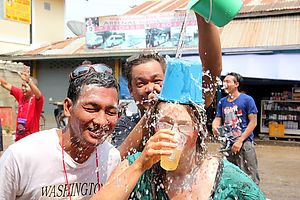 We as young foreigners on bicycles were naturally fair targets for
all variants of the game. Often we got several buckets of water
poured over us, followed by a glass of beer to drink, which we were
expected to finish before being allowed to ride forwards. Children
sprayed us with water guns, sometimes with water coloured in yellow,
green or red. A couple of times we also got white talcum powder
sprinkled on our heads. It was fun to ride around to see and feel
the party.
We as young foreigners on bicycles were naturally fair targets for
all variants of the game. Often we got several buckets of water
poured over us, followed by a glass of beer to drink, which we were
expected to finish before being allowed to ride forwards. Children
sprayed us with water guns, sometimes with water coloured in yellow,
green or red. A couple of times we also got white talcum powder
sprinkled on our heads. It was fun to ride around to see and feel
the party.
 When we wanted to play with water ourselves, we simply stopped at
one of the groups of locals by the roadside. They welcomed us
enthusiastically with an extra dose of water to make sure we'd be
wet enough, we got buckets, a bit of colour to the face and a glass
of beer, and were ready to join the team. So we also poured and
threw water on passers-by, on each other and on everybody around,
wished all Happy New Year and danced to the music. As for the beer,
we tried our best to drink a little bit with everyone while
avoiding to get too drunk. I'd say it worked out quite well.
When we wanted to play with water ourselves, we simply stopped at
one of the groups of locals by the roadside. They welcomed us
enthusiastically with an extra dose of water to make sure we'd be
wet enough, we got buckets, a bit of colour to the face and a glass
of beer, and were ready to join the team. So we also poured and
threw water on passers-by, on each other and on everybody around,
wished all Happy New Year and danced to the music. As for the beer,
we tried our best to drink a little bit with everyone while
avoiding to get too drunk. I'd say it worked out quite well.
 There were also many groups driving around in pickup trucks,
equipped with barrels full of water, buckets, water guns and
sometimes small water bombs. They engaged in water fights with other
pickups and with the teams by the roadside. Even a bigger truck with
a several thousand liter tank of water drove around spraying water
from a big hose. We heard that spraying water directly from garden
hoses and coloured water are actually forbidden, but nobody seemed
to mind. These were joyful water fights where everybody wins.
There were also many groups driving around in pickup trucks,
equipped with barrels full of water, buckets, water guns and
sometimes small water bombs. They engaged in water fights with other
pickups and with the teams by the roadside. Even a bigger truck with
a several thousand liter tank of water drove around spraying water
from a big hose. We heard that spraying water directly from garden
hoses and coloured water are actually forbidden, but nobody seemed
to mind. These were joyful water fights where everybody wins.
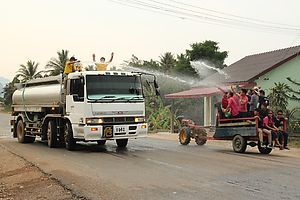 Officially the celebrations lasted for three days, from 14th until
16th of April. Some people started a day or two earlier, but 16th
was really the last day with water play. Eating, drinking and
dancing continued a day or two more, extending the party to a full
week. Most of the activity happened during daytime, from about 10 am
until 5 or 6 pm. In the evening nobody was throwing water any more:
it was time to sit down, eat and drink with friends. Music was
played at all times. In Laos nobody complains about loud music even
at night, especially not during New Year. Still, after 9 or 10 pm
most people went to sleep and it was already relatively quiet.
Officially the celebrations lasted for three days, from 14th until
16th of April. Some people started a day or two earlier, but 16th
was really the last day with water play. Eating, drinking and
dancing continued a day or two more, extending the party to a full
week. Most of the activity happened during daytime, from about 10 am
until 5 or 6 pm. In the evening nobody was throwing water any more:
it was time to sit down, eat and drink with friends. Music was
played at all times. In Laos nobody complains about loud music even
at night, especially not during New Year. Still, after 9 or 10 pm
most people went to sleep and it was already relatively quiet.
 We were impressed by the openness of people welcoming us, even
though we didn't know more than a couple of words of Lao and the
English abilities of our hosts were often on the same level. In
Germany or Finland strangers passing by would not be so easily
invited to join and warmly welcomed to a party. The attitude of the
Lao people was that shared fun is more fun, and everybody is
welcome. That's something we can also try to learn from them.
We were impressed by the openness of people welcoming us, even
though we didn't know more than a couple of words of Lao and the
English abilities of our hosts were often on the same level. In
Germany or Finland strangers passing by would not be so easily
invited to join and warmly welcomed to a party. The attitude of the
Lao people was that shared fun is more fun, and everybody is
welcome. That's something we can also try to learn from them.
Overall, the Lao New Year was one the funniest festivals we've ever been to. People were happy, playful and relaxed, having a good party mood. The water play was sometimes wild, but not rough. If we happen to be in Laos or Thailand (where the festival is called Songkran) in the future at the same time of the year, we'll certainly be on the streets again.

Copyright Arto Teräs <ajt@iki.fi>, licensed under the Creative Commons Attribution-Share Alike 3.0 Unported License. (Unless otherwise mentioned in individual photos or other content.)